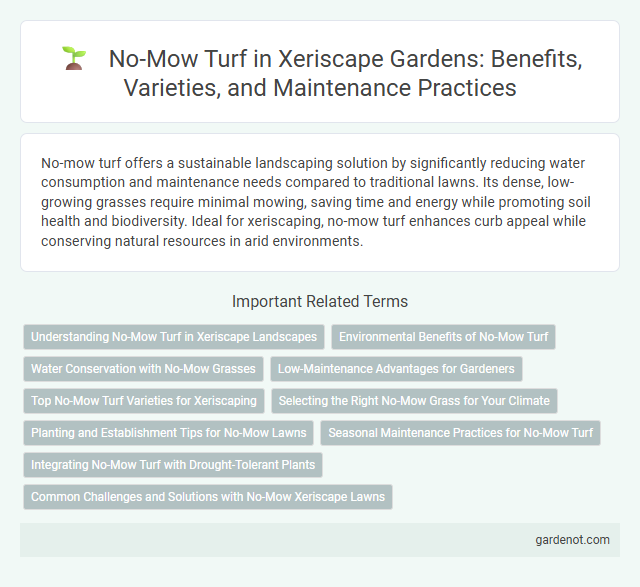No-mow turf offers a sustainable landscaping solution by significantly reducing water consumption and maintenance needs compared to traditional lawns. Its dense, low-growing grasses require minimal mowing, saving time and energy while promoting soil health and biodiversity. Ideal for xeriscaping, no-mow turf enhances curb appeal while conserving natural resources in arid environments.
Understanding No-Mow Turf in Xeriscape Landscapes
No-mow turf, a low-maintenance grass alternative, thrives in xeriscape landscapes by conserving water and reducing the need for regular mowing. This drought-tolerant turf type, such as fine fescues or buffalo grass, maintains a green aesthetic with minimal irrigation, fitting well with xeriscaping principles. Its deep root systems enhance soil health and prevent erosion, making no-mow turf an environmentally sustainable choice for xeriscape design.
Environmental Benefits of No-Mow Turf
No-mow turf conserves water by significantly reducing irrigation needs compared to traditional lawns, promoting sustainable water management. This type of turf supports biodiversity by providing habitat for beneficial insects and minimizing chemical use, which reduces soil and water pollution. Low maintenance requirements decrease carbon emissions associated with lawn mowing, contributing to a healthier environment.
Water Conservation with No-Mow Grasses
No-mow turf grasses significantly reduce water consumption by minimizing irrigation needs compared to traditional lawns, making them ideal for xeriscaping in arid regions. These grasses develop deep root systems that enhance drought tolerance and improve soil moisture retention, effectively conserving water. Implementing no-mow varieties such as buffalo grass or fescue can lower water usage by up to 50%, supporting sustainable landscaping practices.
Low-Maintenance Advantages for Gardeners
No-mow turf offers significant low-maintenance advantages by eliminating the need for regular mowing, reducing water usage, and minimizing the dependence on fertilizers and pesticides. This xeriscape solution thrives in drought-prone areas, promoting sustainable gardening with less labor and cost. Homeowners benefit from increased leisure time and enhanced yard aesthetics without the hassle of traditional lawn upkeep.
Top No-Mow Turf Varieties for Xeriscaping
Top no-mow turf varieties for xeriscaping include buffalo grass, known for its deep roots and drought tolerance, and fine fescues, which thrive in low-water environments and require minimal maintenance. Other excellent options are zoysia grass and dwarf blue grama, both offering dense, low-growing coverage that reduces water usage and eliminates the need for mowing. These turf types enhance water conservation efforts while maintaining aesthetic appeal in xeriscaped landscapes.
Selecting the Right No-Mow Grass for Your Climate
Choosing the right no-mow grass species is essential for achieving a sustainable xeriscape that conserves water and thrives in your specific climate zone. Warm-season grasses like buffalo grass and Bermuda are ideal for hot, arid regions due to their drought tolerance, while cool-season varieties such as fine fescues excel in cooler, temperate climates with moderate rainfall. Matching the grass type to soil conditions and local precipitation patterns reduces maintenance needs and enhances long-term turf health.
Planting and Establishment Tips for No-Mow Lawns
Select drought-tolerant grass varieties such as buffalo grass or fine fescues for no-mow turf to ensure water efficiency and minimal maintenance. Prepare the soil by removing weeds and loosening the topsoil to promote deep root growth and healthy establishment. Water newly planted turf consistently but sparingly to encourage roots to penetrate deeply, reducing dependence on frequent irrigation.
Seasonal Maintenance Practices for No-Mow Turf
No-mow turf requires minimal seasonal maintenance, including periodic dethatching and aeration during early spring to promote healthy root growth and improve soil oxygenation. Applying a slow-release, low-nitrogen fertilizer in late fall supports the turf's winter hardiness without encouraging excessive growth. Regularly monitoring for weeds and applying targeted herbicides only when necessary maintains a clean, sustainable turf environment.
Integrating No-Mow Turf with Drought-Tolerant Plants
Integrating no-mow turf with drought-tolerant plants creates a sustainable xeriscape that conserves water and reduces maintenance. No-mow turf grasses such as buffalo grass or fine fescues thrive with minimal irrigation while complementing native drought-resistant species like lavender, yucca, and sedum. This combination enhances landscape resilience, supports local ecosystems, and lowers overall water consumption in arid environments.
Common Challenges and Solutions with No-Mow Xeriscape Lawns
No-mow xeriscape lawns often face challenges such as weed infiltration, uneven growth, and limited drought tolerance. Integrating drought-resistant grass varieties and implementing regular soil aeration can enhance turf health and resilience. Proper irrigation management combined with selective herbicide use helps maintain a uniform, low-maintenance lawn with reduced water consumption.
No-mow turf Infographic

 gardenot.com
gardenot.com